La naissance du Web en 7 moments clés (2016)
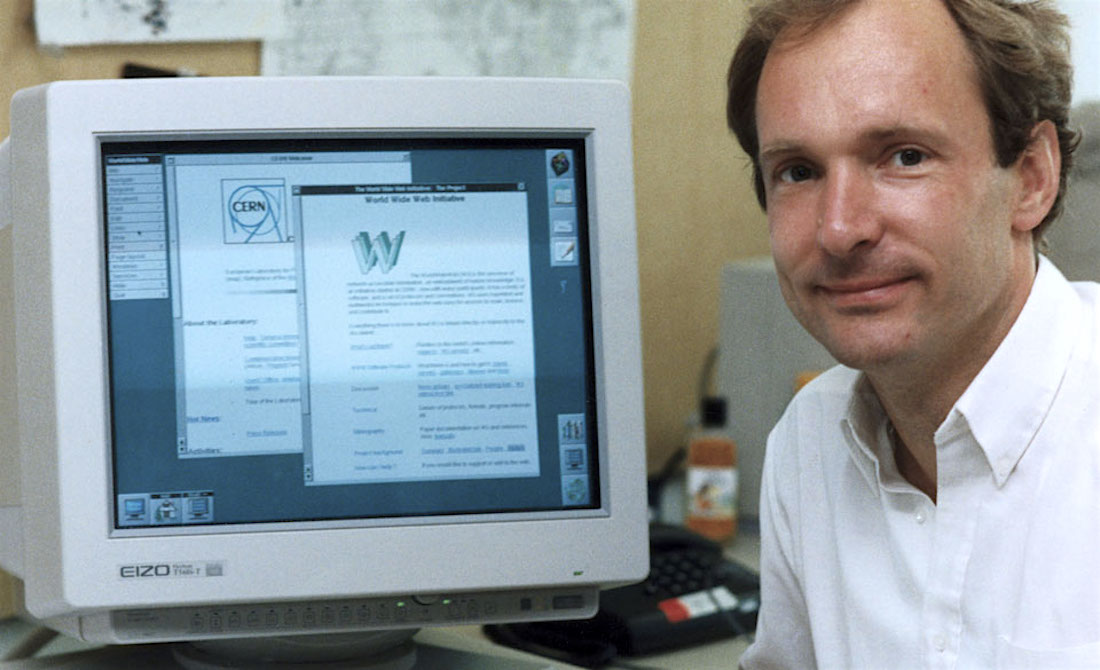
Nous fêtons cette année les 25 ans du lancement du World Wide Web. En 1991, Tim Berners-Lee rendait public le document “WorldWideWeb project” dans différents groupes de nouvelles Usenet, et offrait en téléchargement sur un serveur FTP un navigateur Web rudimentaire en version alpha, le Line Mode Browser. C’était le début de la diffusion mondiale du Web et tout internaute pouvait alors commencer à tester l’outil.
Depuis, le Web a connu le succès que l’on sait, à tel point que cette application sur la suite TCP/IP est devenue dans l’esprit de bien des gens synonyme d’Internet. Cet anniversaire est une bonne occasion de revenir sur sept moments clefs des débuts de l’histoire du Web :
1989
L’idée de Tim Berners-Lee
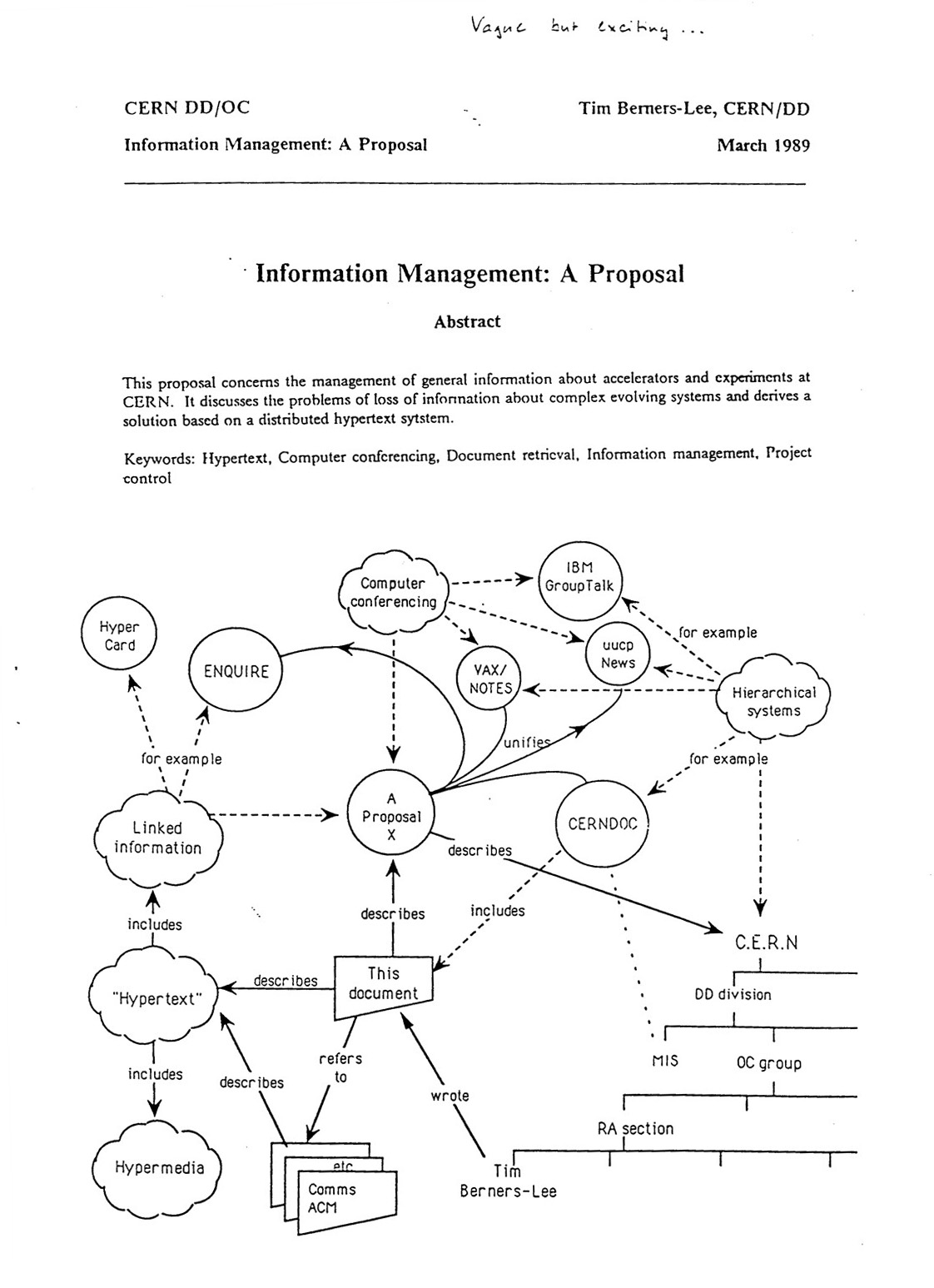
Le Britannique Tim Berners-Lee travaille depuis le début des années 1980 pour le Conseil européen pour la recherche nucléaire (CERN) à Genève. Il trouve extrêmement frustrant le manque de partage d’informations entre les centaines de scientifiques du CERN. L’une des limitations est alors la variété de plateformes informatiques utilisées, non seulement des Mac et des PC, mais aussi des ordinateurs centraux sous Unix ainsi que des systèmes antiques ou exotiques.
En mars 1989, Tim Berners-Lee présente à son supérieur, Mike Sendall, une proposition de système de gestion de l’information pour répondre à ses propres frustrations, un nouveau système basé sur le partage de documents hypertextuels. “Vague, mais prometteur” (“Vague but exciting”), tel est le commentaire que note Sendall sur le document, donnant ainsi le feu vert à Berners-Lee pour continuer à explorer cette piste.
1990
Développement du projet
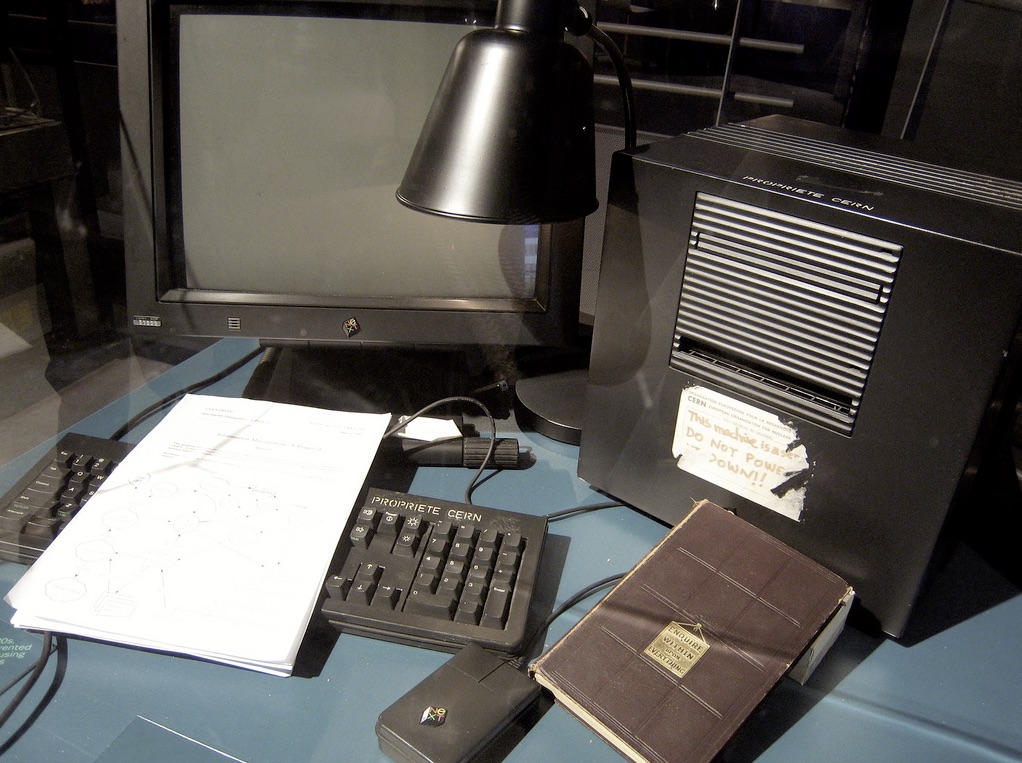
En mai 1990, Tim Berners-Lee soumet à nouveau sa proposition, mais il devra attendre septembre pour que Mike Sendall approuve l’achat d’un ordinateur NeXTcube qui permettrait de commencer à développer le système hypertextuel.
En octobre, Tim Berners-Lee développe l’embryon d’un logiciel permettant d’afficher et d’éditer des documents en hypertexte. Il baptise alors ce programme “WorldWideWeb”.
Le Belge Robert Cailliau, ingénieur en informatique qui travaille dans un autre département du CERN, est le premier converti à l’idée de Berners-Lee et il se propose pour aider au développement du projet de gestion de l’information. C’est Cailliau qui va jouer le rôle d’évangéliste et va secouer tous les cocotiers possibles en quête d’aides et de financements pour le projet de Berners-Lee.
Naissance du World Wide Web
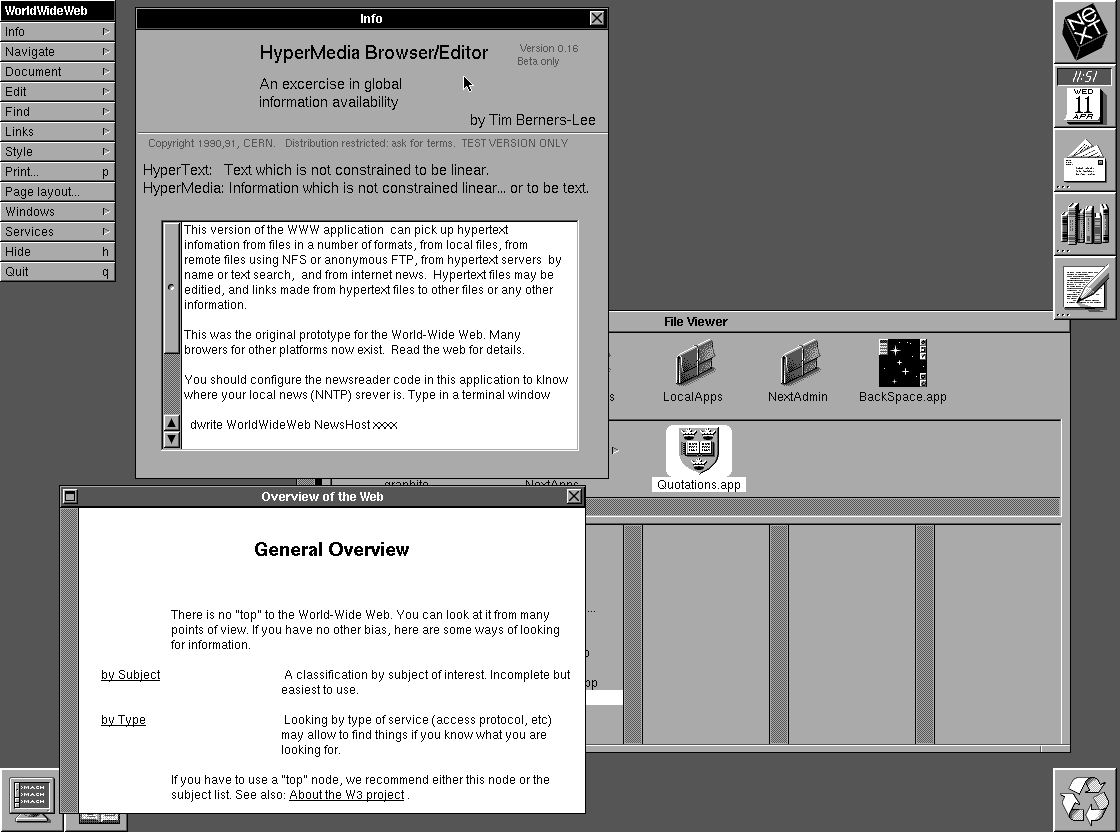
Le 12 novembre, Berners-Lee et Cailliau publient une nouvelle version de la proposition de système de gestion de l’information. Le premier serveur est alors fonctionnel à l’adresse nxoc01.cern.ch et héberge la première page Web, TheProject. Cette date pourrait être ainsi aussi considérée comme la naissance du Web.
1991
Le World Wide Web sort des murs du CERN
En mai 1991, le WWW est déployé sur les serveurs centraux du CERN, ce qui le rend accessible et modifiable par l’ensemble des employés. Les scientifiques disposent enfin d’un outil pour facilement organiser et partager de la documentation.
En août 1991, Tim Berners-Lee publie le projet sur Usenet et donne au monde entier l’accès aux premiers outils (documentation et logiciel).
1992
Le World Wide Web essaime
De nombreuses institutions scientifiques et universitaires, qui connaissent les mêmes problèmes que ceux que vivait le CERN, commencent à s’intéresser de près au projet de Berners-Lee et expérimentent avec les outils.
À la fin de l’année, le World Wide Web est composé d’un peu moins d’une trentaine de serveurs à travers le monde.
1993
Le World Wide Web décolle
1993 est sans doute l’année la plus importante de l’histoire du Web. C’est là que la mayonnaise prend… De nouveaux outils essentiels apparaissent, les serveurs se multiplient et surtout, grâce à l’insistance de Robert Cailliau auprès du service juridique du CERN, le WWW est mis le 30 avril à disposition libre et gratuite de tous, sans brevet ni redevances, ouvrant notamment grand la porte à des utilisations commerciales.
En février, le National Center for Supercomputing Applications (Université de l’Illinois à Urbana-Champaign) rend disponible en version alpha le premier navigateur à interface graphique, Mosaic, pour X Window System, l’environnement graphique fenêtré pour Unix. Dans le courant de l’année, Mosaic est porté sur Macintosh, Windows et Commodore Amiga. C’est le logiciel, ancêtre de Netscape Navigator, qui va permettre de populariser l’usage du Web. En outre, c’est Mosaic qui introduit l'affichage d’images dans une page Web. Berners-Lee, amusé, aurait fait mine de s’inquiéter de cette fonctionnalité : “Mais ça va attirer des gens qui voudront mettre des photos de femmes nues sur le WWW !”. L’avenir prouvera qu’il n’avait pas tort, sans toutefois prévoir la déferlante d’images de minous.

À la fin de l’année, on connaît plus de 200 serveurs HTTP et de grands titres de la presse généraliste (The New York Times, The Guardian, The Economist, etc.) commencent à publier des articles sur le sujet.
1994
Premier Woodstock du Web
Du 25 au 27 mai se tient à Genève la première conférence internationale du WWW. Cette manifestation porte les germes d’une institution dédiée à veiller à l’avenir du Web, le World Wide Web Consortium (W3C), qui sera créée le 1er octobre suivant.

À la fin de 1994, le CERN décide pour des raisons budgétaires (le grand collisionneur de hadrons coûte cher…) de se désengager du développement du WWW et transmet les rênes à l’Institut National pour la Recherche en Informatique et Automatique (INRIA, France). Au même moment, le nombre de serveurs HTTP est de plusieurs milliers, avec des sites comme le Jerry and David's guide to the World Wide Web, le premier annuaire de liens Web, qui deviendra Yahoo l’année suivante, Whitehouse.gov, le site officiel de la Maison Blanche, HotWired, le site lié au magazine Wired, WebCrawler et Lycos, les premiers moteurs de recherche Web.
1994 est aussi l’année de la première publicité sur le Web et de la première pizza vendue en ligne, une grande pepperoni et champignons, avec un extra fromage.
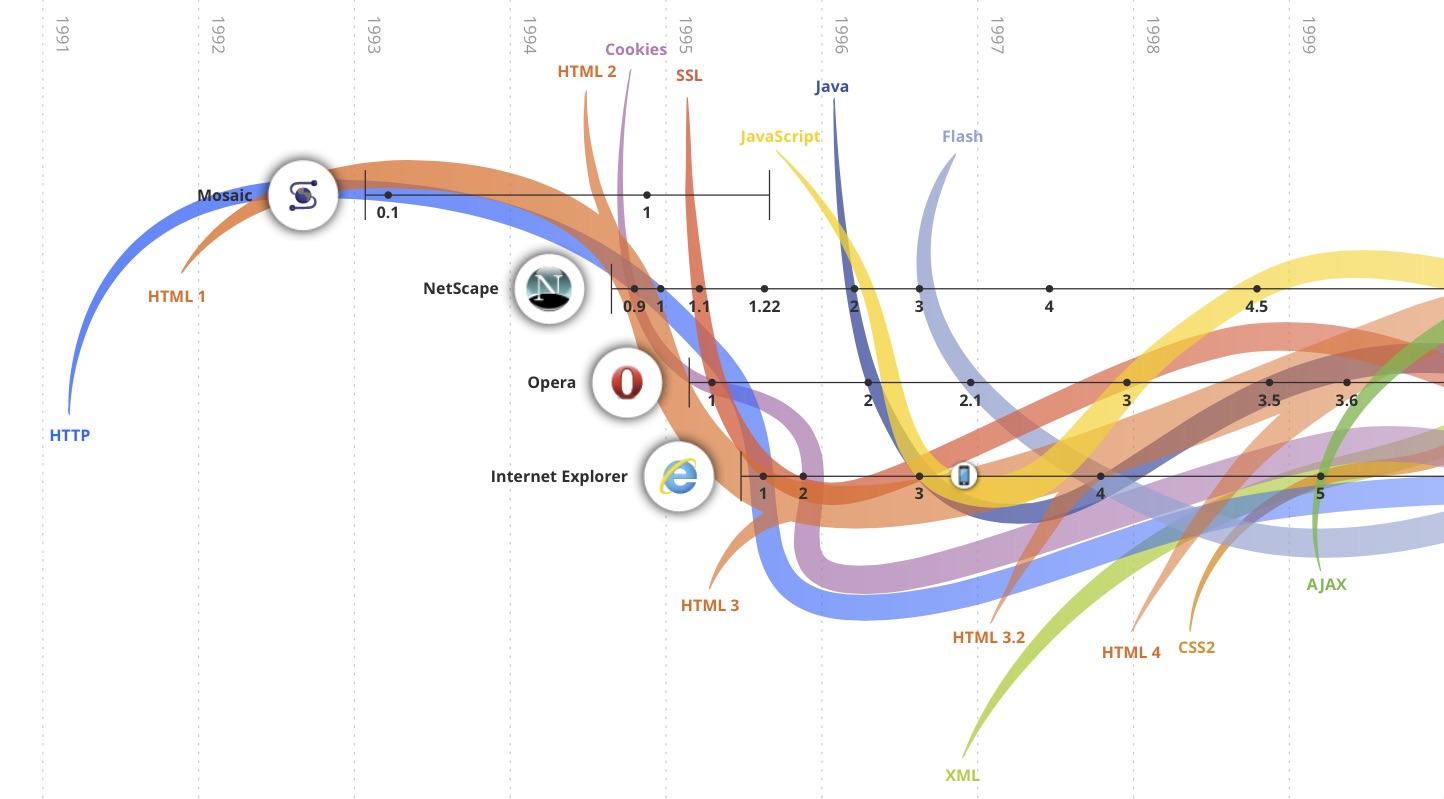
Références
- W3C, Tim Berners-Lee, “Information Management: A Proposal”, 1989.
- W3C, Tim Berners-Lee, “Answers for Young People”.
- W3C, Tim Berners-Lee, “FAQ: Robert Cailliau's role”.
- W3C, Tim Berners-Lee, Robert Cailliau, “WorldWideWeb: Proposal for a HyperText Project”, 1990.
The Birth of the World Wide Web in 7 Key Stages
This year marks the 25th anniversary of the launch of the World Wide Web for the general public. In 1991, Tim Berners-Lee posted the seminal “WorldWideWeb Project” document in various Usenet newsgroups and provided the alpha version of a basic Web browser, the Line Mode Browser, on an FTP server for downloading. This was the start of a world-wide Web that could be used and tested by any Internet user.
Since then, the Web has been so successful that in most people’s mind, the application over TCP/IP has become synonymous to the Internet. Let’s take a few moments to reflect on seven defining moments of the Web:
1989
Tim Berners-Lee’s Idea

Tim Berners-Lee, a Briton, had been working for the Conseil européen pour la recherche nucléaire (CERN) in Geneva since 1980. However, he was frustrated by the lack of information sharing between the hundreds of scientists at CERN. One of the barriers to this communication was the disparity of platforms used: besides the Mac/PC divide, there were several different mainframes operating under Unix as well as antiquated or even esoteric systems.
In March of 1989, Tim Berners-Lee presented his boss, Mike Sendall, with a proposal for information management that would solve the problem: a new information system based on shared hypertext documents. “Vague but exciting”, was the comment Sendall jotted on the proposal, giving Berners-Lee the green light to develop his idea.
1990
Project Development

In May of 1990, Tim Berners-Lee resubmitted his proposal, but it wasn’t until September that Mike Sendall authorized the purchase of a NeXTcube computer that would enable the development of the hypertext system.
In October, Tim Berners-Lee developed a basic software program enabling the viewing and editing of hypertext documents, called “WorldWideWeb”.
Robert Cailliau, a Belgian IT engineer who worked in another department at CERN, immediately saw the potential of Berners-Lee’s idea, volunteering his services to help develop the information management project. Cailliau then lobbied hard to obtain support and funding for Berners-Lee’s project.
Birth of the World Wide Web

On November 12th, Berners-Lee and Cailliau released a new version of the information management system proposal. The first server to come on-line, at nxoc01.cern.ch, hosted the first-ever Web page, TheProject. This date is considered the official birth date of the WorldWideWeb.
1991
The World Wide Web Extends Beyond CERN
In May of 1991, the WWW was deployed on CERN’s central servers, making it accessible and modifiable by all of its employees and giving them a tool to easily organize and share information.
In August of 1991, Tim Berners-Lee released the project on Usenet, giving the entire world access to the WWW’s initial tools (documentation and software).
1992
The World Wide Web Expands
Several scientific and academic institutions experiencing the same communications problems as CERN started taking an interest in Berners-Lee’s project, experimenting with its tools.
By the end of the year, the World Wide Web was made up of about thirty servers across the world.
1993
The World Wide Web Goes Global
1993 was a watershed year in the history of the Web. That’s when it became truly world-wide, with the creation of critical tools and the adding of new servers. Thanks to Robert Cailliau’s representations to CERN’s lawyers, on April 30th, the WWW was made available and free to all, free of patents and royalties, opening up the Web to commercial use.
In February, the National Center for Supercomputing Applications (University of Illinois at Urbana-Champaign) provided an alpha version of the first graphic-interface browser ever, Mosaic, for X Window System, the Windows-based graphic environment for Unix. The same year, Mosaic was adapted for Macintosh, Windows and Commodore’s Amiga. The ancestor of Netscape Navigator, Mosaic is the software that democratized the use of the Web. Mosaic also introduced the concept of adding images on Web pages, causing an amused Berners-Lee to quip: “This will attract people who’ll post pictures of naked women on the WWW!” History proved him right, though even he never predicted the tidal wave of kittens that would submerge the Web.

By the end of that same year, there were over 200 HTTP servers worldwide, and large publications such as the The New York Times, The Guardian, and The Economist started featuring articles on the subject.
1994
The Web’s First Woodstock
On May 25–27, Geneva hosted the first international conference on the WWW. This meeting was the forerunner of the World Wide Web Consortium (W3C), an institution dedicated to shaping the future of the Web, created on October 1st of that year.

At the end of 1994, CERN made the financial decision to concentrate on the (very expensive) hadron collider and to pass the WWW torch to the Institut National pour la Recherche en Informatique et Automatique (INRIA, France). At that time, the number of HTTP servers was in the thousands, with new sites such as Jerry and David’s Guide to the World Wide Web, the first directory of Web links which became Yahoo the following year, Whitehouse.gov, the official site of the White House, HotWired, Wired magazine’s Web site, and WebCrawler and Lycos, the first Web search engines.
1994 also saw the first ad on the Web and the first on-line pizza sale, a large pepperoni and mushroom pizza with extra cheese.

References
- W3C, Tim Berners-Lee, “Information Management: A Proposal”, 1989.
- W3C, Tim Berners-Lee, “Answers for Young People.”
- W3C, Tim Berners-Lee, “FAQ: Robert Cailliau's role.”
- W3C, Tim Berners-Lee, Robert Cailliau, “WorldWideWeb: Proposal for a HyperText Project”, 1990.
